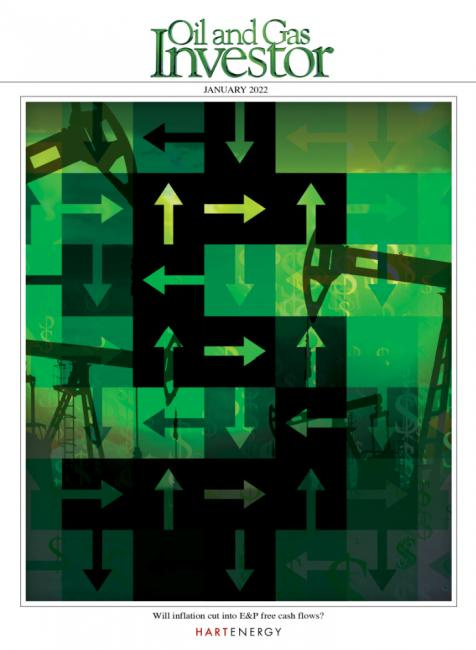
(Source: Hart Energy; Shutterstock.com)
Is $100 oil on its way? Can Europe avoid a fresh spike in natural gas prices this winter? Also, can governments around the world turn last year’s flurry of international climate diplomacy into durable domestic policies and start to bring carbon emissions down? Below is the answer to these questions and what else the energy sector could face this year.
1. Can energy inflation be tamed?
Oil’s surge last year saw the return of the $100 a barrel oil price forecast—a tried and true way for Wall Street analysts to grab their clients’ attention. Will it come to fruition in 2022?
Some of Wall Street’s blue-chip analysts think so. Francisco Blanch, Bank of America’s head of commodities research, says prices could spike as high as $120/bbl in the first half of the year as crude demand continues to race ahead of supply. Goldman Sachs, which has argued the market is in the early stages of a supercycle, is also among those predicting that triple-digit oil is in the cards for 2022.
The forecasts hinge on a couple of key factors playing out this year. First is the global economic recovery continuing at a healthy clip. This would help pull crude consumption back up to pre-pandemic levels of around 100 million bbl/d.
At the same time, oil bulls expect the supply recovery to continue to lag behind demand, fuelling the higher prices. They argue that not enough is being spent around the world to rebuild oil production capacity, America’s shale industry is in a new low-growth era, and OPEC+ will not—or cannot—bring on enough output to cover the gap.
The bull case is no sure thing, but surging global crude prices would cause economic and political shockwaves.
Will inflation cut into E&P free cash flows? Find out more in the cover story in the January 2022 issue of Oil and Gas Investor.

The global economic recovery, already beset by high inflation, would struggle to withstand $100 oil for long and soaring fuel prices would threaten further political instability (of the sort seen in Kazakhstan this week) in a world already set on edge by the continuing pandemic.
Meanwhile, Europe faces an uncertain winter as natural gas prices have surged and stores of the fuel plunged. A cold snap on the continent could bring big bills to European consumers and gas providers. Europe’s gas shortages will also feed a tense showdown between Russia and western nations over Ukraine.
2. Can U.S. oil and gas boom again under Biden?
Joe Biden has promised a long-term transition away from fossil fuels, but he is likely to oversee a booming domestic oil and gas industry in his second year in office. America’s fossil fuel producers are set up for a banner year of bumper earnings and growing output.
The country’s shale producers look to have finally landed on a profitable formula: limited output growth, tight control over spending and a focus on dividends and share buybacks. If oil and natural gas prices remain elevated, analysts are predicting a gush of cash from the shale sector. That is, if they stick to the plan. After a decade of cash-burning growth, the industry has not yet shaken off its reputation for profligacy.
Still, there is likely to be substantial growth from America’s shale patch. The country’s oil output is forecast to be around 12.2 million bbl/d by December 2022, up 600,000 bbl/d from the start of the year, according to the Energy Information Administration. It would firmly install the U.S. as the world’s largest oil producer after output collapsed during 2020’s pandemic-driven downturn.
The U.S. is also set to become the world’s largest exporter of liquefied natural gas in 2022—at least in terms of capacity—surpassing both Qatar and Australia. Strong demand for the fuel, especially from China, has put a tailwind behind a new wave of export facilities and expansions to existing projects.
3. Can the world stop the rise in carbon emissions?
Climate will remain at the heart of policymaking efforts this year as world leaders seek to make good on pledges to “build back better” after the pandemic and urgently stem the rise in global temperatures.
But politics will continue to dog green efforts, as the underwhelming outcomes of the COP26 climate talks in Glasgow last year laid bare.
Countries are being encouraged to increase the ambition of their emissions pledges ahead of COP27 in Egypt this November—though as things stand they are struggling to put substance behind their current commitments.
In the U.S., Democrats will look to resuscitate Biden’s sweeping $1.75 trillion spending bill, which would have made a record $555 billion investment in climate and provided huge tax incentives for renewables. The legislation hit a wall last month when Senator Joe Manchin, a pivotal swing vote, said he would not back it. The West Virginia moderate offered some hope to progressives on Jan. 4, however, by suggesting a compromise on the bill’s climate provisions was possible. “The climate thing is one that we probably can come to an agreement much easier than anything else,” he said.
The spending bill plays a big role in how Biden intends to deliver on his pledge to cut emissions in half by the end of the decade against 2005 levels. Passing the legislation will only become more crucial if the U.S. Supreme Court curtails regulators’ ability to clamp down on greenhouse gases later this year, as expected by many court watchers.
In Europe, Brussels is also pushing to cut emissions through its Green Deal plan. But the divisions within the EU over how to get there were made clear this week as member states clashed over which forms of energy could be classified as green—and therefore benefit from the billions of euros in investment that will be pumped into decarbonizing the bloc’s economy.
And whatever the progress made in the west, much will ultimately hinge on China’s ability to unlock the roughly $6.5 trillion needed over the next four decades to reach carbon neutrality by 2060.
All of this means the aspiration of the Paris agreement to limit warming to 1.5 C will be remain an uphill battle.
This article is an excerpt of Energy Source, a twice-weekly energy newsletter from the Financial Times.
Recommended Reading
TPG Adds Lebovitz as Head of Infrastructure for Climate Investing Platform
2024-02-07 - TPG Rise Climate was launched in 2021 to make investments across asset classes in climate solutions globally.
JMR Services, A-Plus P&A to Merge Companies
2024-03-05 - The combined organization will operate under JMR Services and aims to become the largest pure-play plug and abandonment company in the nation.
Chord Energy Updates Executive Leadership Team
2024-03-07 - Chord Energy announced Michael Lou, Shannon Kinney and Richard Robuck have all been promoted to executive vice president, among other positions.
First Solar’s 14 GW of Operational Capacity to Support 30,000 Jobs by 2026
2024-02-26 - First Solar commissioned a study to analyze the economic impact of its vertically integrated solar manufacturing value chain.
SunPower Begins Search for New CEO
2024-02-27 - Former CEO Peter Faricy departed SunPower Corp. on Feb. 26, according to the company.





